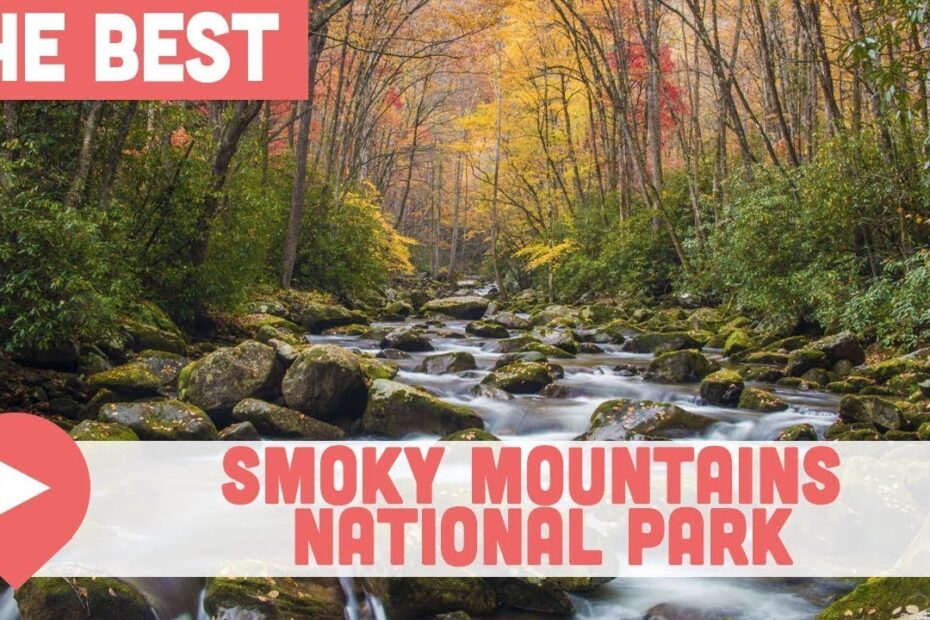Straddling the border between Tennessee and North Carolina, Great Smoky Mountains National Park is a dense region filled with staggering mountains and lush forests. The park’s plentiful sights make it the most popular National Park in the area, and there’s plenty for tourists to the do while they’re there! Join ViewCation as we take a look at the best things to do in Great Smoky Mountains National Park.
Watch the Leaves Change During Autumn
Due to the dense nature of the trees around Great Smoky Mountains National Park, the location is one of the best place in the world for visitors to watch the leaves change during autumn. There are over 100 different tree species located within Great Smoky Mountains National Park, and the wide variety of elevations found within the park allow for a great many vantage points to view them from. If you find yourself in the region during the early fall, you’ll be treated with a plethora of soothing autumn colors filling the landscape, with the peak time being late September.
View the Wildlife While Driving Through Cades Cove
Besides it’s staggering variety of tree species, Great Smoky Mountains National Park also features a staggering variety of animal species. You’re definitely going to want to see as much of the wildlife as you can while you’re in the area, and one of the best ways to do so is to take the scenic drive through Cades Cove. The drive through Cades Cove is an 11-mile loop that takes you through one of the densest natural landscapes in the regions, featuring a gorgeous valley and encroaching mountains filled to the brim with different types of wildlife.
There are said to be well over 1,000 black bears living in the area of Great Smoky Mountains Natural Park, and your chances of spotting a few of them while riding through Cades Cove are exceptionally high! Other animals that you’re likely to spot along the drive include deer, turkey, bobcats, and other smaller animals.
Cades Cove is one of the most popular locations in Great Smoky Mountains National Park, so those who don’t want to deal with crowds during the park’s most popular months may want to try doing the Roaring Forks motor nature trail instead. This trail offers similarly lush sights, with streams and dense forestation. If you’re lucky, you may even see an elk! Besides the two aforementioned scenic drives, there’s also Little River Road, which offers more beautiful scenery.
Hike Along the Appalachian Trail

The Appalachian Trail is one of the most famous hikes in America, and for good reason! The trail is over 2,000 miles long, and spans numerous states from the north to the south of the country. One of the most gorgeous parts of the Appalachian Trail runs along Great Smoky Mountains National Park. The section running along the park is over 70 miles long. Though most visitors to the area won’t be too keen on the prospect of engaging in a nearly 100-mile-long hike in the midst of their vacation, there are numerous smaller, dedicated portions of the section of the Appalachian Trail running along Great Smoky Mountains National Park that can easily be done within the span of just a day.
Besides the 70-mile-long section of the Appalachian Trail running through the popular park, Great Smoky Mountains National Park features over 700 more miles of hiking trails spread over the course of it’s hundreds of thousands of acres. With all of the hiking opportunities available in Great Smoky Mountains National Park, the location can be considered a hiker’s dream! Some of the best hikes in the region include the ones found at Mt. Leconte, Mr. Cammerer, Charlies Bunion, and Andrews Bald.
While there are plenty of incredibly challenging hikes in the region, there are also a bounty of hikes for more easygoing hikers that just want to take in some of the area’s scenery. Some of the more peaceful hikes in Great Smoky Mountains National Park include the Gatlinburg Trail, the Elkmont Nature Trail, the Little Briar Gap Trail, and the aforementioned Andrews Bald.
Climb Atop Clingmans Dome
If you’re look for a fairly steep hike while visiting Great Smoky Mountains National Park, then you should be sure to give special attention to Clingmans Dome. The journey up Clingmans Dome is one of the most popular hikes in the area. Though the path is nicely paved, the uphill journey can be a bit trying for some! There’s plenty of nice scenery all along the hike, but you’ll be treated with some of the best views in the area when you get to the top. There’s an observation tower at the top of the dome, and the top is also the perfect place for watching the sunrise or the sunset.
As with the aforementioned Cades Cove, Clingsman Dome is one of the more popular locations in all of Great Smoky Mountains Natural Park, despite the slight difficulty of it’s steep hike. Those who want to experience the area with a modicum of seclusion may want to go in the morning, or wait until the winter months if they’re good with snowshoes! While the journey up Clingsman Dome may be challenging, it’s worth it when you get to the top and see the incredible view.
If you’re enjoying this video so far, be sure to hit the like button to show your support! Also, subscribe to the channel if you’d like to be among the first to know when more informative ViewCation videos are on their way!
Go Out in the Water on Fontana Lake
If you’re looking to get wet while visiting Great Smoky Mountains National Park, one of the best ways to do so is by visiting Fontana Lake and going out on a paddle board. A dam along the Little River forms the notably skinny lake, which spans well over 200 miles. Besides paddle boarding, visitors to the lake can also go out on the water with kayaks and canoes, or even fish if they’d like! Paddle boards, kayaks, and canoes can all be rented easily within the area.
On the subject of water, the entire region of Great Smoky Mountains National Park is positively brimming with waterfalls thanks to it’s surplus of water and it’s variety of elevations. You’ll find numerous staggering waterfalls while you’re visiting the area, even when you’re not looking for them! Some of the most impressive waterfalls in the region include Abrams Falls, Laurel Falls, and Rainbow Falls, all of which can be found along their own beautiful hikes.
Gaze Upon the Area’s Impressive Plant Life
Not only does Great Smoky Mountains National Park have an impressive bounty of waterfalls, but it also has a staggering variety of flowers. There are said to be well over 1,000 different types of plant flowering within Great Smoky Mountains National Park, with some of the most beautiful types of flowering plants that can be found within the region including such favorites as orchids, trillium, and geranium.
As one might expect, the absolute best time to view the stunning variety of blooming flowers that can be found within Great Smoky Mountains National Park is during the spring months, as well as the earliest months of the summer. Going to the area in April or early May will yield the most lucrative flower-watching results for prospective tourists, but you’ll still be able to see plenty of stunning colorful arrays of flowers up until later during the summer. Of course, you can’t see the blossoming flowers of the Great Smoky Mountains and the autumn leaves changing colors during the same timeframe, so you’ll have to plan your trip accordingly!
Experience the Life of a Pioneer
Long before the land of Great Smoky Mountains National Park was designated as a National Park, it was simply land that was being used by the settlers of the region to go about their daily lives. As soon as the land was declared a National Park, preservation efforts were put into effect in order to try and keep as many of the buildings from this time period standing as possible in order to preserve the pioneer history of the region. Because of this, Great Smoky Mountains National Park is now home to a great many historical buildings that can give visitors a look back through history and a taste of what it was like to be a pioneer.
There are said to be nearly 100 historical buildings existing with the boundaries of Great Smoky Mountains National Park, with a great many of these buildings being found along the aforementioned Cades Cove. While driving along Cades Cove, you’re liable to see plenty of old churches from the region’s pioneer days, but that’s only the tip of the iceberg when it comes to the greater amount of historical buildings in the region. Other hotspots for historical buildings that can be found within Great Smoky Mountains National Park include Oconaluftee and Cataloochee.
At Oconaluftee, you’ll find the Mountain Farm Museum. This stunning museum consists of a variety of old structures leftover from the region’s pioneer days, with an emphasis on farming technology. Down the road, you can find the equally notable Mingus Mill. In Cataloochee, you can see a preserved school from the pioneer time period, as well as more churches and several houses.
Stay in a Cabin
While you won’t be able to stay in any of the aforementioned historical buildings, you can do the next best thing! For those who are looking to experience a multi-day trip to Great Smoky Mountains National Park like a pioneer, staying the night in one of the area’s many rustic cabins may provide the perfect opportunity. There are many different types of cabins to rent in the area, with some being fairly luxurious.
With all of the amazing opportunities for visitors, it’s no wonder that Great Smoky Mountains remains one of the South’s preeminent outdoors destinations. Now it’s time to hear from you: did you know that there are around 1,500 black bears existing within the boundaries of Great Smoky Mountains National Park, and that the region also features a surplus of stunning waterfalls? As always, like this video to show your support, and subscribe and hit the notification bell if you’d like to be among the first to know when more informative ViewCation videos are on their way!
